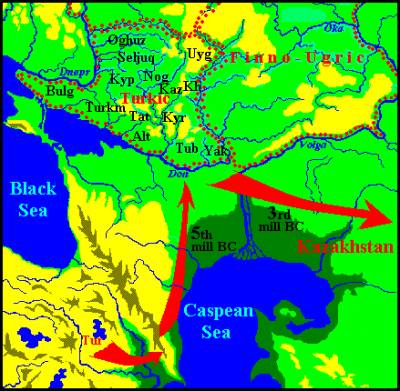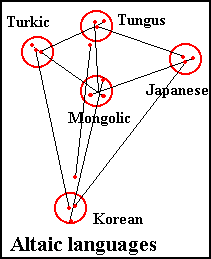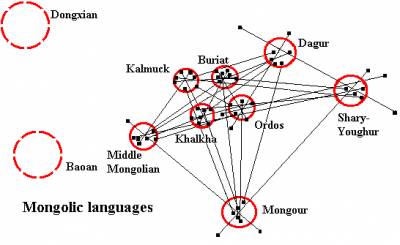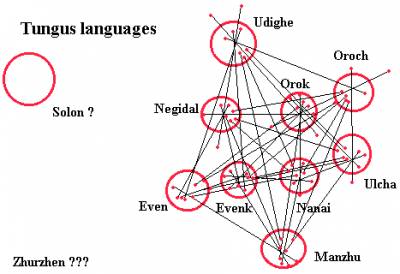|
The Relationship of the Altaic and Turkic languages.
"It has been suggested that the Turkish, Mongolian and Tungus languages form such a family, commonly called the Altaic, and that they are all descended from a lost primaeval language called Altaic or Proto-Altaic. For some years now I have been coming more and more to the opinion that this is an error and that the fact that these languages gave a good deal of vocabulary material in common is best explained, not by assuming that they have inherited it from a common ancestor, but by assuming that a prolonged and complicated process of exchanges has taken place between these languages. … I am quite convinced that Turkish is not genetically related to either of them". (CLAUSON GERARD, 2000: Studies in Turkic and Mongolic linguistics. London, New York: 36).

One can add to the words of Sir Gerard that Japanese and Korean are considered to be belonged to the Altaic family. Earlier, using the graphical-analytical method, we found the Turkic Urheimat in the South Caucasus (see The Nostratic languages. ) and then localized the habitats of Turkic tribes speaking particular dialects, originated from the common parent Turkic language, in East Europe (see The uprising of the Turkic Languages) . Only to the end of the 3rd mill BC the most part of Turkic tribes crossed the Don and dispersed in the Volga river basin, the Northern Caucasus, and further in the steppes of Kazakhstan. In such way they arrived to Altai. Such assertion contradicts Altaic theory of the origin Turkic languages based upon the fact of common features between the Turkic and Mongolic languages. But these common features can have other explanation as genetic relationship. At first we have to find the Urheimat of the other Altaic languages using their graphical models. The lexical material for constructing these models was found in the International Etymological Database Project The Tower of Babel.
 The Proto-Turkic language quite well fit to the general model of relationship of the Altaic languages what can say about their common genetic origin. For the final clarification of the issue, it is needed to find the territory of arising of the Altaic languages. As the graph has only five knots, it can be placed ion different places in Europe or Asia. To facilitate the search for the exact location, we have to construct the separate models of relationship of the Mongolic and Manchu-Tungus languages, which number is enough for the confident placing them on assumed places of Ethno-generating areas . Having received such survey, it will be easier to establish the place of formation of the other Altaic languages

The group of Mongolic languages consist of the Middle Mongolian, Dagur, Buriat, Ordos, Kalmuck, Mongour, Khalkha, Shary Youghur, Baoan, Dongxian and some other languages or dialects. We set as principle the classification of the Mongolic languages made by Russian linguist Sergey Starostin and took for constructing graphic models of these languages the lexical material of the International Etymological Database Project The Tower of Babel Maybe the model can be completed by data of other languages but these data are not available in the meanwhile.

The languages of Tungus (Manchu-Tungus) group are spoken by the people of Eastern Siberia and Manchuria. Many of them are endangered to vanish but their vocabularies are composed by Russian linguists. The construction of the graphic models of Tungus languages was also made by means of the International Etymological Database Project The Tower of Babel
Having three graphical models it was enough easily to find the territory of the primeval settlements of the speakers of the Altaic languages in the Amur River basin and adjacent areas where the ethno-forming areas were situated. According to the model of relationship, the Korean language, the most remote from the rest of the Altai, just was formed on the peripheral area, which was the Korean peninsula. That the Koreans populate this territory at present is an additional fact in favor of the correctness of the location of the graph. The ancestors of modern Japanese dwelt in the territory of Primorye, well limited by the rivers Ussuri and the Amur, and the Sea of Japan. From there they moved to the Japanese island trough Sakhalin, either directly on the frozen sea. The particular Mongolic languages were arisen on the common Altaic basis in the ethno-forming areas created mostly by tributaries of the Songhua River and the right tributaries of the river Amur. Obviously, no special Proto-Mongolic language existed, so the closer relationship between the Mongolic languages, comparing with other Altaic languages, can be explained by the proximity of areas of their formation and the boundaries being easy to overcoming. The same can be said of the Manchu-Tungus languages, with the only difference that they were arisen in the basins of the left tributaries of the Amur River (see the map below).

The territory inhabited by the Turks, was supposed to be on the Trans-Baikal region limited on the east by the river Argun, which separated them from the territory of the Mongolian tribes. Thus, we can assume that in the early second millennium BC, when the Turkic tribes left their ancestral home in the area between the rivers Dnieper and Don, and moved eastward. Scattering in Kazakhstan, ancient Turks created the Andronovo culture in this area. After arriving to the forest zone east of the steppes near Altai, the Turkic tribes came into contact with the indigenous population. Archaeological studies resulted that there were two large independent tribe associations on the territory of Mongolia already from the end the 3rd mill BC. One of these associations (the eastern) was related to Mongoloid population, and the second (western) had Europeoid origin
View The Mongolic abd Tungus languages in a larger map
Belonging to the Mongolian anthropological type, the local inhabitants subsisted on fishing, hunting, and food-gathering that is, they were still at a relatively low level of social development. Archaeological data suggest that "agricultural" features in the economy of the Amur country began to show only in the 3rd-2nd mill BC (BROMLEY Yu.V., 1986: 257), and the development of agriculture can be connected precisely with the arrival here Turkic tribes. Until that time, the system of oral communication of the aboriginal people was not yet enough developed, in accordance with their primitive economy, it was rather poor, while the newcomers, the Turks were at a higher level of cultural development and use much more advanced languages. While adapting to the more advanced economy of new settlers, the consequence was massive infiltration of the Turkic lexical and grammatical forms in the language closest neighbours – the Mongols and Tungus, and from these languages in languages of more eastern ethnic groups. In this way, the Turkic and Mongolic languages acquired some formal similarities which deceive to-day linguists as if the Altaic and Turkic language families have the same genetic origin. Meanwhile, commingling between two populations resulted the acquisition of Mongolic physical traits by the Turkic peoples. Later, during the Mongolic expansion since the 13th century, the reverse process of borrowing from the Mongolic to Turkic languages started quite naturally. Mongolic loan words in the Turkic languages hid the question about relation the Mongolic and Turkic languages still more. Sir Gerard Clauson noted that “the existence of this massive volume of Mongolic intruders seems somehow to have escaped notice, or, if noticed, to have been regarded by those who accept Altaic theory as evidence of a common “Altaic” heritage in both language groups” (CLAUSON GERARD, 2000: XI). Exactly such circumstance gave us a chance to construct the graphical model of typological relation of Altaic languages.
The hypothesis about the nature of the rhotacism and zetacism in the Altaic languages
One of the puzzles of the Altaic languages is the nature of the phonetic correspondence r/l – š/s (z). This complex phenomenon assumes the existence of two groups of Turkic languages, differing as follows. Similar phonetically words of the same sense can have on the same position either the sounds r, l, or š, s, z. For example, the name of a bull is pronounced in many Turkic languages öküz, ögüz, but Chuvash has văkăr.
Accordingly, these groups are called by scholars r (l/r)-languages and z-languages. The latter are called also standard languages. At present the group of r-language consists of the Chuvash language at present, but it is assumed that other r-languages existed too. However, we can often find even among the z-languages that semantic near words of the same stem can have as the sound z, and the sound r on the same position. For example, the Turkic word semiz “fat" corresponds to the verb semir-“ to fatten, get fat, grow." In addition, some z-languages have r sound in the place where the other have z: Tur. yasa "law, statute" - Karachi džoruq «law», with Kaz., Uzbek. tezek, tizak "manure" - Gag. ders «the same». Thus, a there is no clear pattern of sound transformations in this matter.
The competent British specialist in Turkic philology, uniting l/r-languages into a single one, points to its peculiarities and difficulties of its research by such words:
“Our knowledge of l/r Turkish is so fragmentary and discontinuous that it is better not to attempt to trace its history in detail, remarking merely that the difference between l/r Turkish and standard languages was primarily in the pronunciation of certain sounds and probably only to a small extent in matters of word structure, grammar and vocabulary”. (CLAUSON GERARD. 2002: 44-45)
It is assumed that the Altaic languages had a certain sound, a sonorant or fricative, which later was preserved in one part of the Turkic languages, but the other part reflected it as the alternative. Correspondence r/l ↔ š/s/z in the Turkic languages are quite numerous. For many years, scholars disputed what the sound was original the sonorant or fricative. Evidences in favor of the first and second assumption exist or rather, are treated, fairly conclusive. According to the two positions of scientists, two lines have been developed in the Turkic phonology - the "zetacism" and "rhotacism" theories. The term "rhotacism/lambdaism" is used sometimes too. While some scientists named preservation of archaic r/l by "rhotacism/lambdaism", others understood this term as the transition of primary š, s or z. in r/l. Accordingly the zetacism could be understood as conservation of the sounds š/s/z or the transition r/l in these sounds. This different understanding did not help to resolve the problem, it is still unclear. We can find in the literature directly opposite conclusions about trends in the development of views on this issue. Some believe that it becomes more and more adherents of the rhotacism, others write the same about the supporters of the zetacism. (PALLO MARGIT K. 1985:87: PETROV L.P., YEGOROV N.I. 1987: 90)
The complexity of the problem is in addition complicated by the false conception of Altaic origin of the Turks and about the supposed genetic relationship of the Turkic languages with the Mongolian and Tungus-Manchu groups. Based on this conception, it goes without saying that any deviation from the common-Turkic norms should have been common in some cases for the Chuvash, on the one hand, and the Mongol or Manchu-Tungus languages, on the other. It is known that the Chuvash language stands alone among the whole set of Turkic languages and it was natural to assume that some of its features should draw it together with the Mongol languages. While searching Chuvash-Mongolian linguistic relations scholars clearly overdone and often gave for such coincidences or far-fetched analogies. This applies to the problem of the rhotatcism-zetatcism. The assertions of a large number of Chuvash-Mongolian lexical correspondences that contain the sounds r and l on those places where the vast majority of Turkic languages have š/s/z wander from book to book.
However, in practice it turned out that the Mongolian-Chuvash correspondence are not so much. This is acknowledged by some linguists:
"The Chuvash language has a number of Mongolian words not found in other Turkic languages. It is above all Pronouns ... More Mongolian-Chuvash corespondences are few, but enough to prove coexistence of the Proto-Chuvash and Mongolian peoples in the distant past - long before the Mongol conquest" (AKHMETIANOV R.G. 1978: 119).
Except for pronouns, which analysis is a matter for specialists, the cited paper gave six or seven Chuvash words having matches in the Mongolian language, but that does not mean that other Turkic languages had them or they never existed in these or Old Turkic languages. A similar phenomenon can be observed in the Hungarian language, where there are present separate Hungarian-Mongolian lexical matches. On this occasion, the famous Hungarian linguist Zoltan Gomboc wrote:
“The fact that in some cases, matches to the Hungarian words can be found only in the Mongolian language .. has not really matter, as the ancient Turkic vocabulary is known to us not in all full” (GOMBOC ZOLTAN. 1985-1: 29).
On the other hand, some of the Chuvash-Mongolian matches can not be absolutely considered as ancients, if we pay attention on the meaning of words ("tin", "a shawl"). And, as always, there may be a coincidence. Such a bias inherent also to many scholars finding Chuvash-Mongolian phonetic correspondences, in particular the r/l ↔ š/s/z. The list of matches, compiled on the basis of data collected online from the international project "The Tower of Babel", established under the leadership of S.A Starostin, is given below. The senses of the Chuvash words were specified in the dictionary.
Chuv çěrě “a ring”, Turkm, Kasrach jüzük, etc. “a ring” – Mong dörü “a ring”.
Chuv jěr “a track”, Trc iz, yz, “a track” – Mong irağa “a shoot, wave”.
Chuv kěr “outmen”, Trc küz, güz, “outmen”, – Mong qura “rain”.
Chuv var “middle”, Trc üz, öz “inside” – Mong örü “inside, chest”.
Chuv samărt “fat, well-fed”, Trc semiz “fat” – Mong semž’i “interior fat”.
Chuv šur “swamp”, Trk saz “swamp” – Mong sirağu “earth”.
Chuv sěr “to filter”, Trc süz, söz “to filter” – Mong sürči “to drizzle”.
Chuv takăr “even, flat”, Trc tegiz, tekiz “even, equal” – Mong tegsi“even, flat”.
Chuv čěrçi “knee”, Trc diz, tiz, dize “a knee” – Mong türei “a bootleg”.
Chuv tar “to run away”, Trc tas, “to run away”, – Mong tergil“to run away”.
Chuv türě “right”, Trcdüz “right” – Mong töre “a rule, law”.
Chuv vărax “slow”, Trc uzun, uzaq “long” – Mong urtu “long”.
As we can see, the list is small, and some matches may be pure Turkic origin, and their Mongol correspondences are just borrowing. In addition, the absence of the Mongolian correspondences to the most ancient Turk words having obvious signs of rhotatcism-zetatcism such as, for example, qyz “a girl" or ögüz “an ox” is to be taken in consideration. Thus there can be no question of absolute regularity in accordance Shuvash and Mongolian r modern Turkic z. However, even a few indisputable Chuvash and Mongol correspondences should be given some explanation. Since, as, in consequence of our studies, the speakers of the ancient Chuvash and Mongol language had no the prehistoric era, but, nevertheless, some facts of common phonetic phenomena exist in these languages, we can make an assumption about the existence specific sounds in the ancient Turkic language, one of which could be easily transformed in r, and s/z, and the other in the l and š. The phenomenon of rhotatcism-zetatcism is known in some Indo-European languages (Latin, German). Since the formation of the Turkic languages took place in the immediate vicinity of the settlements of Indo-Europeans in Eastern Europe (STETSYUK VALENTYN. 1998), one could admit that the phonetics of the Turkic and the Indo-Europeans languages had some common features. Thanks to preserved ancient texts, the phonetics of the Indo-European languages was recovered better than the Turkic one. One of its features is the presence of aspirated sounds bh, ph, th, dh, etc. In addition, the Greek language had affricates ks (ξ), ps (ψ), dz (ζ). It has long that N. Marr developed his theory about the development of speech sounds from simple to complex. These complex sounds might break up into more simple sounds of modern languages, and some of them might exist till now.
In our case, the hypothetical sound that could transit as in r, and in s/z is a fricative trill rz, existing now in the Czech language (ř) and existed in Polish (rz) but transformed into ž or š depending of the sonority the preceding consonant. Was it the original Proto-Slavic sound, which goes back to the Indo-European, or it evolved in the Polish and Czech language under the influence of the Bulgars, who lived some time in the neighborhood with the ancestors of the Czechs and Poles have yet to figure out science, but in any case two r - the long and the short, or the hard and soft, or the simple and complex had to exist in the Slavic languages. Thus, nothing prevents us assume the existence of the sound rz in the ancient Turkic language, what has been already done before (STETSYUK VALENTYN. 2000: 29). But there were not only in Slavic two sounds r, the same can be said about the Armenian language which has the sounds r and rr (long). In this case just the long Armenian sound corresponds to the hypothetical Old Turkic rz, as it is evidenced by the ancient Armenian-Gagauz lexical parallels: Arm antarr "forest, wood" corresponds Gag andyz "grove, bush". Similar words for a forest in Armenian and Gagauz have survived from the days when Proto-Armenians and Oguz (Gagauz ancestors) settled adjacent habitats, they are both originated from the ancient word antarz.
The part of the Turks, migrated later to Asia, brought their phonetic features also there. The forebeers of the Mongols and Tungus, borrowing many Turkic words, articulate the sound rz/rs as r at ones, while the Bulgars simplified its pronunciation in the usual r much later, but the same result of replacing the complex sound in the more simple one gives the warrant to talk about imaginary Bulgar-Mongolian (Chuvash-Mongolian) relation, which in fact never took place.
The rhotacism phenomenon, that is replacing the phoneme z (s) by the phoneme r, known in Latin since the 4th century BC, has taken place also in some West-Germanic languages (YEGOROV V.G. 1971: 25). Some phonetic facts of the Ukrainian language may also produce evidence in favor of the existing of the sound rz: Ukr. zherst’ - Rus. zhest’ “tin”. This word was borrowed from the Turkic languages where it had meaning "copper, brass", in the form jes, zes, zis, etc. The unclear r in the Ukrainian word can suggest an idea that the word was borrowed at the time when the sound rz still existed. That is, the Turkic protoform can be restored as *zerz. Then, if existing the parallels *zelz, it becomes possible to explain the hitherto obscure etymology of Proto-Slavic *zelzo "iron".
There is another very interesting match, confirming the existence of phonemes rz. Latin cursarius, from which the word corsair was derived, can have such parallels: Chuv xarsăr "bold", Karachi, Balk. ğursuz "evil" Tur hırsız "a thief" and other Turkic words derived from the ancient *ğurzurz. Usually the etymology of the Latin word cursarius is explaining from Lat. curare "to escape", but, undoubtedly, the Turkic words are semantic much closer to one of the names of the pirates. The word hussar, which originated from Hung huszár, can be referred here too. The Hungarian word is consonant to the ethnonym Khazar, what have already called attention (KESTLER ARTUR. 2006: 21). Arthur Koestler believes that, except word hussar, the word Cossack here could be included here (Ibid). The Albanian language has the word kusar “a thief," which summarizes all the made assumptions made. Once upon a time it had the form hurzarz, but later the both original sound rz turned in one case in s, and in another one - in r, ie specified fricative trill could even in the same language have different transformation, depending on the convenience of pronunciation. Taking all this into account, we can look otherwise at denomination of the Khazars by Leo Deacons as Kharars (LEO the DEAKON. 1988). Scholars believe this was a simple slip of the pen, but in fact such reflection is just caused by the protoform harzarz. The inconsistency of the transition initial rz may be due to the fact that "the Turkic languages are often avoided two consecutive r” (ERDAL MARSEL. 2005: 129). A. Rona-Tas believes that noted in fountain-heads the Turkic form of the name Khazars qazar “goes back to the title 'qasar', which originated from the name 'Caesar', as the title of 'Emperor' and 'king'" (RONA-TAS ANDRAS. 2005: 113.). Rather, the Latin anthroponym Caesar descended from the Turkic word. This example is interesting because it has two sounds rz, one of them turned to z, while the other kept the old sound. However, it is possible that it also turned to z, if the word Cossack (in principle, the "robber") has the same origin.
The Relationship of the Sino-Tibetan languages
The Anthropological Type of the Autochthon Europeans
The North Caucasian Languages
The Urheimat of the Nostratic Languages
| |

















